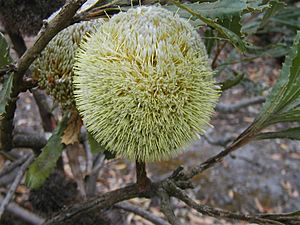Banksia laevigata subsp. laevigata facts for kids
Quick facts for kids Tennis ball banksia |
|
|---|---|
 |
|
| B. laevigata subsp. laevigata, cult. Banksia Farm | |
| Scientific classification |
|
| Kingdom: | Plantae |
| Clade: | Tracheophytes |
| Clade: | Angiosperms |
| Clade: | Eudicots |
| Order: | Proteales |
| Family: | Proteaceae |
| Genus: | Banksia |
| Species: | |
| Subspecies: |
B. l. subsp. laevigata
|
| Trinomial name | |
| Banksia laevigata subsp. laevigata |
|
The tennis ball banksia (its scientific name is Banksia laevigata subsp. laevigata) is a small, woody shrub. It belongs to the plant genus called Banksia. You can find it growing in the dry, shrubby areas of Western Australia. It's one of two types of Banksia laevigata, the other being the golden ball banksia.
Contents
How the Tennis Ball Banksia Got Its Name
The Banksia laevigata plant was first described by a Swiss botanist named Carl Meissner in 1856. He studied a plant that James Drummond had collected in 1848.
Later, in 1964, another botanist named Alex George found a slightly different type of this plant. He named it a new subspecies, which automatically gave the original plant the subspecies name laevigata.
The common name, "tennis ball banksia," comes from its flowers. When they bloom, they look a lot like tennis balls!
What Does the Tennis Ball Banksia Look Like?
This banksia is a shrub that can grow up to 3.5 metres (about 11.5 feet) tall. It has grey, flaky bark.
New leaves and stems grow in the summer. When they are young, they are covered in soft, fine hairs. These hairs fall off as the plant gets older.
The plant has two main types of leaves. One type, found near the Fitzgerald River, has rounded teeth along its edges. The other type, found in the Ravensthorpe Ranges, has larger, sharper teeth.
Its flowers appear in spring, usually from October to December. They are oval-shaped and a greenish-yellow colour.
Where Does the Tennis Ball Banksia Grow?
The tennis ball banksia grows in Western Australia. You can find it in the dry, shrubby areas near the lower Fitzgerald River and in the Ravensthorpe Ranges. It prefers to grow in stony soils, like those made of spongolite or laterite.
This plant is considered "Priority Four - Rare" in Western Australia. This means that while it is rare, it is not currently in danger of disappearing. Experts check on it every 5 to 10 years to make sure it stays safe.
How Does the Tennis Ball Banksia Help Nature?
Like other banksia plants, the tennis ball banksia is important for many creatures. It provides food for pollinators like ants, bees, and wasps. These insects help the plant make new seeds.
Can You Grow a Tennis Ball Banksia?
It is possible to grow the tennis ball banksia. However, like many banksias from Western Australia, it can be sensitive to a plant disease called Phytophthora cinnamomi dieback.
Even with this challenge, people have successfully grown it on Australia's east coast. It has also been successfully joined onto another type of banksia called Banksia integrifolia through a process called grafting.
George, Alex S. (1981). "The Genus Banksia L.f. (Proteaceae)". Nuytsia 3 (3): 239–473.

